Technically, anything involving two people competing can become a sport. However, many cultures have adopted watching specific sports as a widespread recreational activity.
For that reason, it helps to penetrate that sport (and get along with that culture) simply by understanding the base rules of that nation’s favorite sport.
These rules are enough to penetrate the sport, but are not exhaustive enough to cover all the basics. The rule-setting varies by each league, and there are always new adaptations that try changing those core rules.
It’s important to note that sports often become less safe by adding safety features.
- Typically, the motivation to implement a safety feature is to protect the players.
- However, the increased safety means a higher threshold for taking risks, meaning people become more reckless.
- Moving from leather to plastic football helmets means players can use their head as a battering ram, and it increases the risk of concussion.
- Moving from leather to padded boxing gloves means boxers can safely strike the face, which increases the risk of brain damage.
- Generally, safety features should protect a player from suffering a severe injury, but permit them to still suffer pain from behavior that violates the rules and would have hurt otherwise.
Field/Court Sports
The essence of a team sport is for multiple people to work together to get a small object into a goal. That goal will vary, and the available maneuvers for the players will often be very limited.
Soccer/Football
Most of the world plays some form of football, though it’s called soccer by countries that have their own “football” sport (which is typically not foot-related compared to “soccer”).
There are many leagues for football, especially in Europe:
- FIFA – Fédération Internationale de Football Association (operates internationally)
- UEFA – Union of European Football Associations Champions League (Europe)
- EPL – English Premier League (UK)
- Bundesliga (Germany)
- La Liga Santander (Spain)
- Serie A (Italy)
The ubiquity and formalization of soccer gives 17 very specific, broad rules:
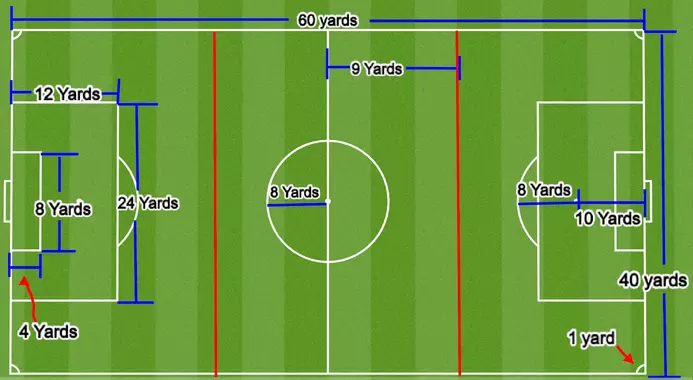
- The field (or “pitch”) is usually grass, and is 90–120 meters by 45–90 meters with white lines (“touchline” and “goal line”) and flag posts demarcating the boundaries. There are also lines indicating the center circle where the game starts, where the goalie must stay, and the penalty area.
- The ball is an inflated sphere about 27 inches in circumference, usually decorated black-and-white.
- The game involves each team having 10 people running around the field, with 1 goalie (22 people total), and 3–12 substitutes as backup. They generally group into defense (near their own goal), midfield, and attack (near their opponent’s goal).
- Every player must wear a jersey with sleeves, shorts, socks that cover shin guards, and footwear.
- A referee has full authority to enforce the rules.
- Other game officials can officiate alongside the referee, up to ~8 more.
- The game has two 45-minute halves, with a half-time break that’s never more than 15 minutes, and any game delays will get added to the end of the half.
- A game starts with a kick-off from the center of the field, with each team being on their side of the field.
- The ball is only in play all the time until it passes over the goal line or touchline.
- The game is determined by goals scored.
- A player commits a vastly complicated-to-explain “offside offense” when they’re nearer to the goal line than their second-to-last opponent and receive the ball.
- A foul is any action considered dangerous or gives an unfair advantage for one of the players or teams. This includes kicking, tripping, jumping at, charging, striking, pushing, holding, and spitting at an opponent. They’ll get a yellow card if it’s serious enough, and a second yellow card with a red card for the second offense, meaning they’re ejected from the game without a replacement. A severe infraction means an immediate red card.
- A player gets a free kick from where the offense happened. A direct free kick is for a physical altercation or handball, and an indirect free kick is for almost everything else and requires them passing to another player to attempt the shot.
- A player gets a penalty kick if their opponent committed a penalty in their penalty area, and it’s a free shot from 12 yards away from the goal.
- If a player sends a ball out of play over the touchline, the opposing team gets to “throw-in” to another player.
- If a player sends a ball out of play over the goal line, the opposing team gets to “goal kick” it to another player.
- A corner kick must be from the side of the field where the ball went out.
American Football
American football is much more significant in the USA than anywhere else in the world. The most well-established American football leagues are the NFL (National Football League) and NCAA (National Collegiate Athletic Association) Football’s Division I, both in the USA.
American football borrows many of its rules from traditional football, but adjusts them a lot. The spirit of football appeals to strategic thinking and aggressive competition.
The ball is an oblong shape with pointed ends, and is usually made of leather.
The uniforms of each player include a damage absorbing helmet, plastic body armor, jersey, pants with foam pads in them, and cleats.
The field is 53 1/3 yards wide (“sideline” to sideline) and 120 yards long (“goalpost” to goalpost), with 10 yards on each end creating an “end zone” and many labels for yard markers. The goalposts are at the far end of the end zone for field goals and extra points.
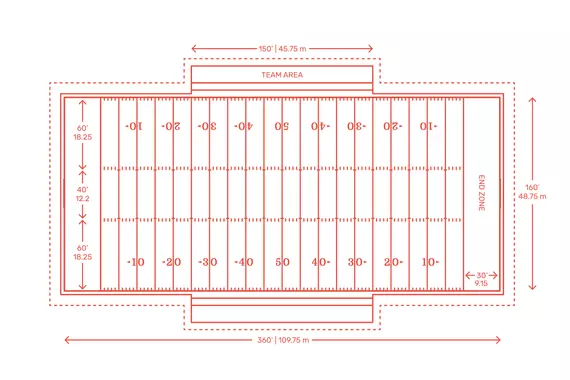
There are still 11 players on the field for each team, but they break out into 3 main divisions of offense, defense, and special teams. Most coaches’ diagrams involve showing their expected pathways as well.

- Offense comes out when the team has “possession” of the ball, and they’re responsible to advance the ball down the field each play. They generally consist of:
- A quarterback who first receives the ball after the “snap”, makes “audible” calls to change the play, and either throw, run, or hand off the ball based on the situation. Only 1 throw per play can be forward toward the end zone, and the rest must be “lateral” (backward or sideways).
- 5 offensive linemen who protect the quarterback from the defensive linemen, which includes a center who snaps the ball.
- A running back who either runs the ball on the inside of the field or blocks for the quarterback.
- A tight end who can block for the quarterback or run farther down the field for the quarterback’s short passes.
- 3 wide receivers who run far down the field to catch the quarterback’s pass.
- It’s worth noting that many coaches rearrange the ratio of various players, and that each position’s group has its own subdivided names.
- Defense tries to block the offense advancing the ball by either “sacking” the quarterback, tackling whoever has possession of the ball at that moment, or “intercepting” a pass. They consist of:
- Defensive linemen who charge the quarterback or tackle the running back or tight end.
- Linebackers who read whether the play is running or passing, then react to it.
- Cornerbacks stay close to wide receivers and try to catch the ball instead of them.
- Safeties are hybrids of linebackers and cornerbacks, and tend to adapt to the strategy of the coach.
- Special Teams come out whenever the ball needs kicking:
- During the beginning kickoff at the start of a game or when a team scores (different groups for kick versus kick “return”).
- During a punt or punt return (more on that later).
- During an extra point attempt or extra point “block” (more on that later).
- During a field goal attempt or field goal block (more on that later).
Every game has 4 quarters with 15 minutes of clock time, with a halftime (and maybe a show) in between Q2 and Q3, and a few-minute break in between the other two breaks. If the score is a tie, it goes into another quarter.
The game starts with a coin toss, with the winner team choosing if they’ll kick or return. After the halftime, it’ll swap.
The game runs through a type of rhythm:
- After the kickoff, the kick return will run the ball back, trying to reach the end zone, but will likely be tackled along the way, marking the start of the “first down”.
- Kick return team swaps for offense and kickoff team swaps for defense. Offense has to move the ball forward 10 yards without being tackled to the ground sometime within “second down”, “third down” and “fourth down”. Only the player in possession of the ball can be tackled.
- If they succeed, the new location becomes “first down” again. If they don’t succeed, there’s a “turnover” and offense/defense will swap.
- On the fourth down, the punt team can come out to try kicking the ball as far as possible, which gives more distance for the opposing team to cover, but guarantees a turnover.
- If a player runs or catches a ball in the end zone, it’s a touchdown and worth 6 points. If the ball is kicked in as a field goal attempt, it’s worth 3 points.
- Extra point attempt team comes out to kick the ball through the goalposts, which is relatively easy to do. Otherwise, they’ll try a one-run attempt (a more difficult endeavor) to get a “two-point conversion”.
- Return to another kickoff by the team that scored the point.
Because American football is full-contact, there are many penalties, referred to as fouls. Most fouls give the other team more yards. Personal fouls are severe misbehavior, and can lead to ejection from the game. Dead-ball fouls are outside the normal course of the plays.
The clock keeps running unless a player runs out of bounds, a pass is incomplete, or a coach calls a timeout. At the last two-minute mark, the clock stops and there’s a two-minute warning, which tends to heighten the drama of the final part of the game.
Ice Hockey
There are other forms of hockey that are adaptations on soccer/football, but ice hockey is unusually popular compared to the others, probably due to the extra effort required while skating on ice. The most prominent hockey league is the NHL (National Hockey League) in the USA.
Hockey pucks are hard discs that slide across ice, and the players try to strike the puck with a curved stick to get it past the goal line inside their opponent’s net.
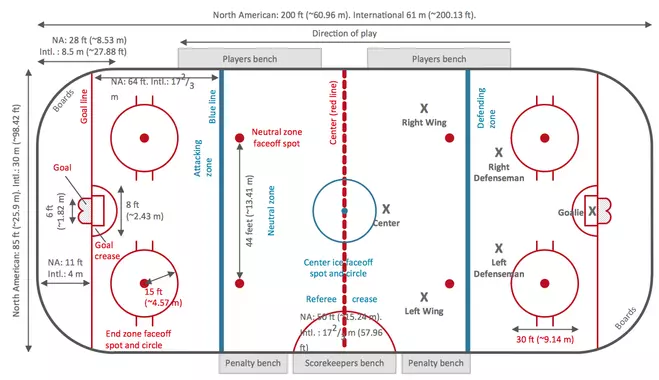
The ice hockey rink is an 85-foot or 30-meter by 200-foot or 61-meter oval-shaped ice field with barriers around its perimeter. It has several grouped domains:
- Boards on either far end behind the goals.
- An attacking zone and defending zone, relative to the players. There is a small semicircle called a “goal crease” that defines the goalie’s boundaries, a net and a red line defining the goal boundary.
- A neutral zone that constitutes about 1/4 of the center of the rink, with a center-ice line.
- Boxes on each side for people to enter and exit the ice: players’ benches on one side, and the penalty benches and scorekeepers’ bench on the other.
- There are 9 face off zones spread around the ice, with the starting face off in the exact center.
Every game is made of 3 periods at 20 minutes each, with 17-minute intermissions. During that time, a Zamboni can clean the ice for another round. If there’s a tie, it goes into a 5-minute overtime period, with the next score immediately ending the game. If nobody scores in overtime, there’s a shootout to determine the winner.
To accommodate the danger of the puck and the risks from the ice, everyone must wear skates, gloves, helmets, shoulder pads, specialized pants, shin guards, and elbow pads. The goaltender also has special gloves and a lot of extra padding.
Each team in hockey has only 5 skaters and one goaltender (down from field hockey’s and football’s 11):
- The goaltender stays within the goalie box and is the only one who can grab a puck.
- The wings are “forwards” who patrol the left and right sides of the ice, and are trying to score or pass to other players who have a better opportunity to get the puck into the net.
- Defencemen protect the goaltender and prevent the wings from scoring.
- A center is in the middle of the ice, and starts the face off.
Since ice hockey is on ice, there is a lot of contact, and many rules ensure the game stays safe and continues going. This involves keeping the stick close to the ground, not striking or grappling anyone, and not using the stick as a weapon. And, since ice is a somewhat foreign element, this can lead to a lot of aggression:
- Minor penalties send a player to the penalty box for 2 minutes.
- Major penalties send them for 5 minutes.
- Misconduct will send a player to the box for 10 minutes.
- If a player had a “breakaway” (a clear path to the net with nobody but the goalie) and stopped from behind by an illegal contact, the player will get 1 chance for a shot without any other players on the ice.
- A delayed penalty comes when a team breaks a rule, but doesn’t get possession of the puck, and will come into effect as soon as they get the puck.
The rules vary depending on the league, but a few ground rules almost always apply:
- When a player is in their defensive zone, they must reach the center-ice line before they shoot or pass, or they’ll receive a penalty for “icing”.
- The puck should always enter the attacking zone first, and a player who enters it before the puck is “offside”.
- A player can only pass to another player across one line (i.e., not too far down the rink), or they’ll receive an “offside pass”.
To keep track of everything, there are many officials:
- A referee is the main on-ice official, and calls any penalties that occur.
- A linesman watches the play at the blue lines to ensure there aren’t any offsides, offside passes, or icing.
- A goal judge watches the red line to see when a goal has happened.
- An official scorer who tracks goals, assists, and many details involving penalties.
Cricket
Cricket originated in the UK, but the two largest cricket leagues are the IPL (Indian Premier League) in India and the KFC Big Bash League in Australia.
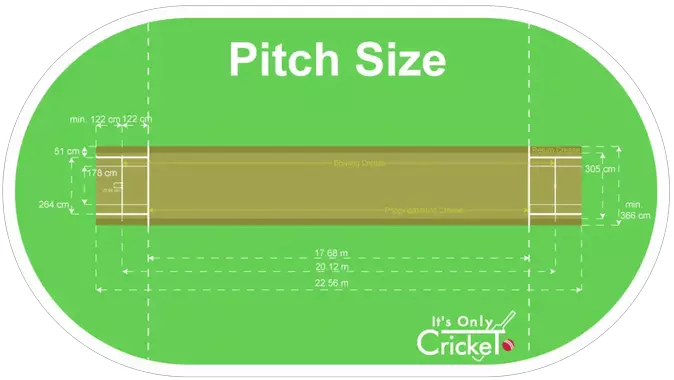
The field is about 200 meters in circumference, typically oval, and has several components:
- A rectangular pitch in the center that’s 22 yards long by 10 feet wide, with a wicket in the center of it.
- There are no markings on the field except the pitch, with each part divided by 4 types of “creases” on the ground.
- A “popping crease” (or “batting crease”) that marks where the batter is no longer safe from the fielding team.
- 2 “return creases” run parallel to the long edges of the pitch.
- A “bowling crease” runs parallel to the popping crease that determines where the bowler must stand, which divides that section into 2 rectangles.
- Each end of the pitch is marked with creases, with a rectangle of open space between them in the center of the pitch.
- There are 3 28.5-inch stakes called “stumps” driven into the ground at the center of the bowling crease across 9 inches, with cross-pieces called “bails” in between them.
- A close infield 15 years wide on both sides of the pitch and an oval infield with a 30 yard perimeter.
- An outfield that extends to the end of the field.
It’s worth noting, there is a lot of jargon for various places on the field:
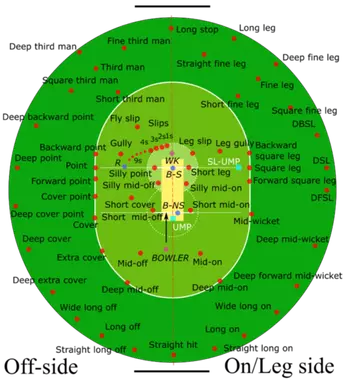
A cricket ball is solid and small, and is designed to be easily thrown. At the top end, it can travel 90 miles an hour or 140 kilometers an hour.
Each team has 11 players, with the defending team “fielding” while the “batting team” has 2 on the field starting at each wicket. The fielding team has different roles that can adapt as the game progresses:
- Bowlers throw the ball at the wickets and are supposed to throw the ball at or below the waist before they reach the popping crease.
- Batsmen from the opposing team stand in front of their wicket. The batsman facing the bowler is the “striker”, while the other one at the far side of the pitch is the “non-striker”.
- Wicket-keepers stand behind the wicket at the striker’s end of the field.
- Fielders all have their own colloquial names, but none of them are official.
The goal of cricket is for the strikers to score “runs” against the fielding team by striking the ball, then running from one point to another before the fielding team can either end the play or run out the batter.
- If both batsmen can safely exchange places, they get 1 run, but no points if either one is “out”.
- If batsmen successfully score a run, they can immediately turn around and try to score another run, as many times as they think they can succeed. It’s possible to get more than 4 runs on a bowl, but very rare.
- If a batsman hits the ball out of bounds, and it bounced at least once, they immediately get 4 runs. If it didn’t bounce before it landed out of bounds, they get 6.
There are quite a few specific ways a batsman can be out:
- The bowler directly hits the striker’s wicket and “breaks” it, and the striker was “bowled”.
- The batsman is outside the popping crease and the bowler broke the wicket with the ball (which may include simply hitting it), and the striker was “run out”.
- Non-strikers can often leave the popping crease as the bowler is about to bowl, and the bowler can break the non-striker’s wicket instead for a different run out.
- The striker misses the ball while attempting to hit it, steps outside the popping crease, then the wicket-keeper cleanly catches the bowl and hits the wicket with the ball, which means the striker was “stumped”.
- The striker intentionally uses any part of their body to block the ball from the wicket, they’re out “leg before wicket” or LBW.
- The striker hits their wicket accidentally somehow while trying to hit the ball or attempting to run, which is called a “hit wicket”.
- A fielding team member catches a striker’s ball before it touches the ground, which is “caught out”.
- A batsman touches the ball with any hand not holding the bat, which is “handling the ball”.
- A batsman tries to use their bat or body to swat away a ball already in play or interferes with the fielding team’s efforts, which is “obstructing the field”, though running to be between the fielder holding the ball and the batsman’s wicket is still legal.
- Striking the ball twice on a bowl for any reason except scooting it away from their wicket is still an out.
- If a batsman doesn’t replace the other batsman called out within 2 minutes, they’re “timed out”.
- However, if the striker hits the ball to it and flies directly into the non-striker’s wicket, the non-striker is not out, though the bowler can still pick up the ball and redirect it at the non-striker’s wicket.
The flow of the game transitions through several clearly divided phases:
- Every time the bowler bowls the ball counts a tally (whether the striker hits it or not), and 6 times in one direction is an “over”.
- When a batsman is declared out, they must leave the field and be replaced by a teammate.
- Every “innings” is a single period of gameplay for an entire batting team, and it can have any number of “overs” (innings is always plural, even if there’s only 1).
- There’s a set number of overs predefined for an innings. However, a fielding team can also end an innings early if they score 10 outs, since there aren’t any batsmen to fill 2 spots on the pitch anymore.
- Each team alternates 1 or 2 innings, depending on the game’s length.
Extra runs can be awarded for several reasons:
- A call of “no ball” after an illegal bowl, which gives another bowl in the same over, with 1 run awarded even if no runs are scored on a “no ball” over.
- If a bowler bowls “wide” (i.e., above the batsman’s waist or sails past the sides of the pitch), the batting team gets another bowl, and automatically scores 1 run either way.
- If the striker tries to hit the ball but misses, and the wicket-keeper doesn’t catch it, the batsmen can score runs called “byes”.
- When the striker tries to hit the ball with their bat but hits with their body instead, they receive a “leg bye”.
Baseball
Baseball originated in the USA, but is directly inspired from cricket. The most well-established basketball leagues are the MLB (Major League Baseball) in the USA and NPB (Nippon Professional Baseball) in Japan.

The field is in a diamond shape tailored for long-distance ball travel:
- A batter’s box where the batter stands. It has a “plate”, 3-foot wide left and right box (for left and right-handed batters), and an 8.5-foot wide catcher’s box behind the plate.
- Foul lines that extend from the batter’s boxes at exactly 90 degrees from each other.
- 3 other plates arranged in relationship to the batter’s plate as a square with 60-foot sides. The batter’s plate is “home plate”, the right plate near the foul line is “first base”, top plate is “second base”, and left plate near the other foul line is “third base”.
- A center, slightly elevated mound of dirt approximately equal distance from all 4 plates called the “pitcher’s mound”.
- A generally recessed area behind the plate called a “dug out” where the team stays when not in play, with a “next batter’s circle” nearby to let them warm up.
- An outfield that extends further at least 175–200 feet, but can go up to 400 feet.
Just like cricket, a baseball is solid and small, and is designed to be easily thrown. At the top end, it can easily travel 90–100 miles an hour.
The goal of cricket is to score “runs” against the fielding team by striking the ball at home plate, then running through first, second, and third base before the fielding team can either catch the ball before it hits the ground or get a runner “out” before they’re “safe” at a plate. A batter becomes a “runner” the moment the ball is struck.
Each team has 9 players, with the defending team “fielding” while the “batting team” sending each batter one at a time to the plate. Unlike cricket, the fielding team has very specific roles:
- Pitchers try to throw the ball past the batter without them striking it.
- Catchers catch whatever the pitchers throw.
- 3 basemen guard their plates and are called first baseman, second baseman, and third baseman.
- The short stop stands between the second and third baseman.
- 3 outfielders run out to their respective areas: left fielder, center fielder, and right fielder.
The flow of the game transitions through several clearly divided phases:
- The game is divided into 9 “innings” with a “top” and “bottom” based on which team is “at bat”, with an “extra inning” added at the end one-at-a-time if there’s a tie.
- Each inning gets a small break, but the middle of the 7th inning traditionally gets a “seventh-inning stretch” to give the audience time to relax and visit the concession stand.
- The top and bottom of each inning continue play indefinitely until the team has had 3 “outs”.
The rules at bat are more advanced than cricket’s:
- The batter receives a “strike” when the ball goes over the plate near the batter’s waist (inside the “batter’s box”) and they don’t “swing”, swing and miss, or it connects but travels beyond the foul line on either side (a “foul ball”).
- The batter receives a “ball” when the pitcher throws the ball outside the batter’s box and they don’t swing.
- After 3 strikes, the batter is out, unless it was a foul ball.
- After 4 balls, the batter “walks” to first base, with the runner on first base going to second, and so on if there aren’t any gaps.
- If the pitcher hits the batter, the batter “walks” to first base.
- Traditionally, the audience gets to keep foul balls they catch that travel into the stadium.
- If the batter strikes the ball beyond the limits of the field, they’ve made a “home run” and get a free run around all the bases (which scores for every runner as well).
- At any time, a fielding player who catches a ball struck by the batter before it hits the ground will make that batter out, including a foul ball or home run.
When the batter connects, the runners will try to advance bases, and the runner can either be “tagged out” (touching the runner with the ball directly, but not throwing it at them) or by the fielding member catching/holding a ball while they’re touching the destination plate of the runner.
The strategy of baseball has created its own tactical phrases as well:
- The pitcher can throw various balls including a “fastball”, “curveball” or “screwball”. They used to be able to throw a “spitball”, but that was made illegal.
- The trajectory of the ball has an impact on the play:
- A “fly ball” arcs into the outfield.
- A “pop-up” or “pop fly” arcs into the infield.
- A “line drive”, “liner” or “rope” travels in a straight line, typically not far from the ground.
- A “ground ball” or “grounder” is a low-trajectory ball that tends to hit the ground and roll or bounce.
- Sometimes, the batter can choose to “bunt” by holding the bat in front of them instead of swinging to ensure they’ll get a grounder instead of a fly ball.
The officials who oversee baseball are called “umpires”, and there’s usually one right behind the catcher and a couple near first and third base.
Australian Football & Rugby
Rugby is directly inspired by soccer/football going back to 1823, with the idea of using your hands as part of the sport, and it likely influenced American football as well.
The objective of the game is to touch the ball down in the opponent’s in-goal area, or “tryzone”. This scores a “try” that’s 5 points, and the ball must touch the ground.
- If a team scores a try, they can attempt a “conversion kick” worth 2 points.
- When a team member breaks a rule or 2 or more players stop the play of the game, the opposing team member gets to attempt a penalty kick worth 3 points.
- If the ball is played backwards to a “back-row” player, that player can perform what’s called a “drop goal” or “field goal” that kicks the ball in for 3 points.
A rugby ball is inflated like a soccer ball, but is oblong and shaped a bit like a small watermelon.
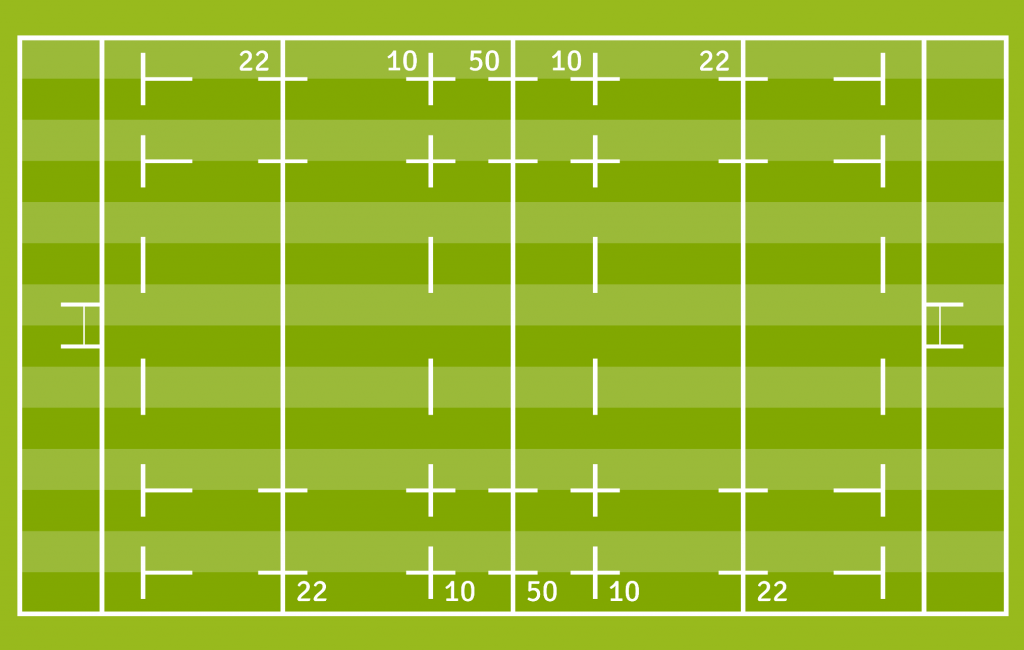
Rugby fields/pitches are 94–100 meters long (from “goalpost” to goalpost) and 68–70 meters wide (from “touchline” to touchline), with other lines to demarcate:
- The “dead-ball line” is 6–22 meters away from the try line.
- The “try line” or “goal line” defines where a player can score a try and is aligned with the goalposts and spread from touchline to touchline. The goalpost is 3 meters above the ground with a 5.6 meter crossbar at least 3.4 meters tall, and touching the goalpost pads is also considered a legal try.
- The 5-meter line is to indicate the 5-meter scrum, and the 22-meter line marks out the 22-meter drop out.
- There are perpendicular lines 5 and 15 meters from both touchlines to clarify the lineout.
- The 10-meter line is dotted across the field 10 meters away from the halfway line.
- The halfway line is where kickoffs happen when a match restarts.
During play, the ball can only be thrown backward or sideways, and is generally passed diagonally to teammates. Dropping or “bobbling” the ball counts as a forward pass if it hits your hands before it hits the ground in front of you. The only way to move the ball forward is by kicking it or running.
Stopping another player requires tackling them. Only the ball carrier can be tackled by wrapping hands around them (rather than spearing with the shoulder, only below shoulder height, can’t pick them up and drop them, and must return to your feet before trying to “win” the ball from them.
A player who goes down must release the ball, and from there anyone can fight to win the ball off the ground:
- A “ruck” usually happens after a tackle, where 1–3 players from each team lock into one another right above the ball (and tackled player), and push each other back-and-forth to win “possession”. At this point, nobody can grab the ball.
- One player on each team will stand behind the ruck and can legally grab the ball when it appears behind their rucking teammate’s back foot.
- A “maul” is when the ball is not on the ground, one or more opposing players is holding the ball carrier, but one or more teammates bind on as well.
- The tackled player can put the ball down wherever they want, so the team that had the ball first usually controls it.
When a penalty is called, there are several types of restarts, one of them being a scrum”, where both teams weave themselves together and connect over the ball. This can create the most significant gain, but is also the most dangerous part of the sport.
If the ball goes out of bounds, there’s a “line-out”, which is like a throw-in in soccer, but the ball must be thrown directly forward and everyone stands between the perpendicular pitch lines. Teams will often use signals and codes to win their own line-outs, often by hoisting a teammate up to catch the ball out of the air.
There are two forms of rugby union: rugby 15s and rugby 7s, though there are other variations that feed into those two (touch rugby, beach rugby, rugby 10s, rugby 12s).
Rugby 15s have 15 players on each team, arranged into 8 “forwards” or “packies” clustered closely together and 7 “backs”: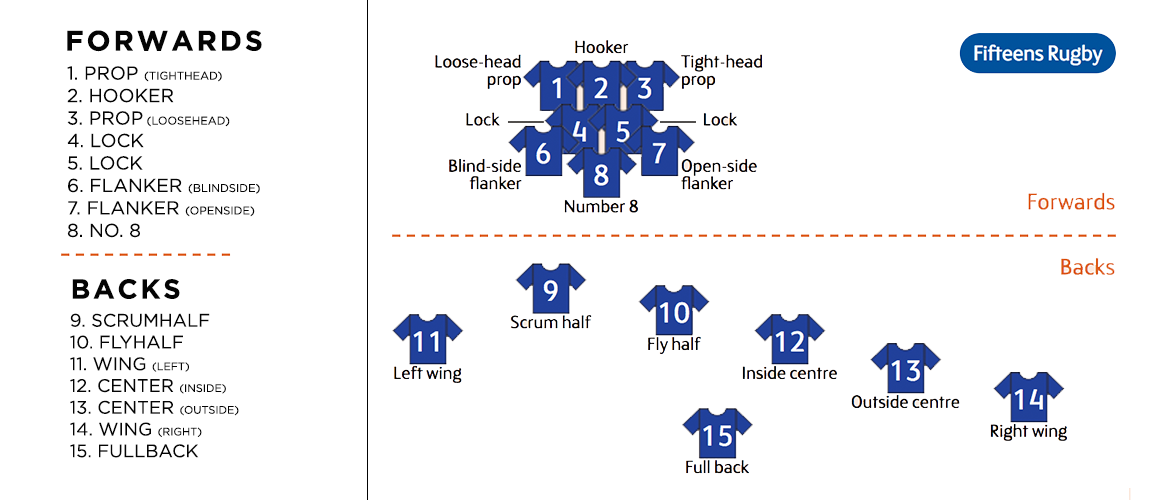

Rugby 7s shaves it down to 7 players per team:
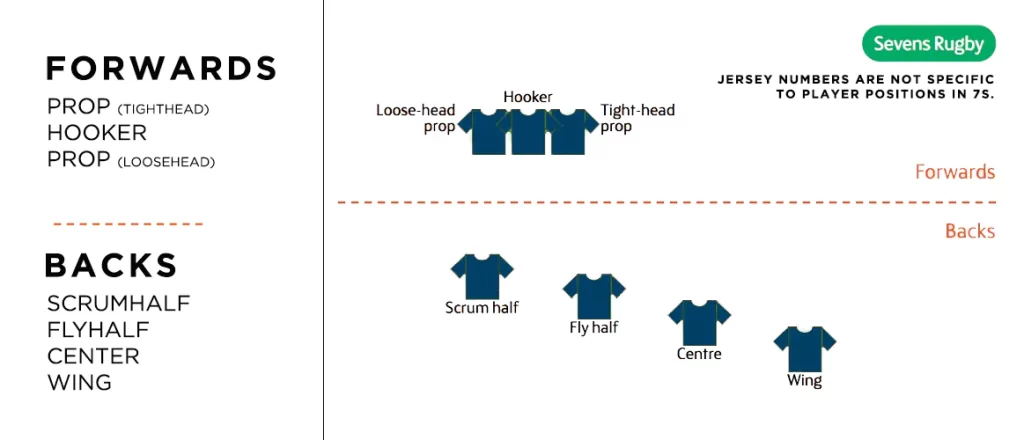
A 15s match lasts for 2 40-minute halves, while a 7s match is 2 7-minute halves and up to 3 matches per competition day.
There are multiple types of penalty calls:
- The attacking team kicks the ball and it goes over the dead-ball line, so the defending team has a scrum from where the attacking team kicked it.
- The defending team kicks the ball from in-field over the dead-ball line, so the attacking team will have a scrum from the 5-meter line.
- The defending team kicks the ball from the in-goal area over the dead-ball line, so they will take a 22 meter “drop out”. However, the kicker can also choose to take it behind that line.
- Except for a scrum, a player can’t interact with play if they’re farther down the field than the ball, or they’ll receive an “offside” penalty.
- All kickoffs must go past the 10-meter line, or the opposing team is awarded a scrum on the halfway line.
- A “sin bin” is when a player is removed from the game for 10 minutes (in 15s) or 2 minutes (in 7s) for dangerous play or serious infringements.
Australian football is deviated directly from rugby, and the most well-known Australian football league is the AFL (Australian Football League):
- Its field is nearly twice as long and more than twice as wide, with an oval shape.
- The ball is egg-shaped, with a more pronounced hump than rugby’s.
- There are 18 players on the field instead of 15.
- There are 4 quarters of 20 minutes instead of 2 halves of 40.
- Beyond scoring by “carrying” the ball into the in-goal area, there’s a complex additional scoring system for kicking the ball in.
- There are no offside penalties.
Small Court Sports
Basketball
Basketball is by far the most well-known indoor sport. The most well-established basketball leagues are the NBA (National Basketball Association and NCAA (National Collegiate Athletic Association) Basketball’s Division I.

The 13 rules were pretty straightforward in 1892 which involved dropping an inflated orange ball into a nailed-up peach basket, but more has been added since then:
- The ball may be thrown in any direction with one or both hands.
- The ball may be slapped in any direction with one or both hands.
- A player cannot run with the ball and must throw it from the spot he catches it, with allowance for catching the ball while running.
- The ball must be held in or between the hands, without arms or body involved.
- Nobody is allowed in any way to shoulder, hold, push, trip or strike their opponent. person of an opponent shall be allowed. The first time is a foul, and the second disqualifies him until the next goal or, if there was clear intent to hurt them, for the rest of the game, without substitutes.
- A foul is striking the ball with the fist, violation of rules 3 and 4, and such described in rule 5.
- If either side makes three consecutive fouls without the other side making a foul, the other side receives a goal.
- A goal is when the ball is thrown or batted from the ground into the basket and stays there (without falling), providing those defending the goal don’t touch or disturb the goal. If the ball rests on the edge, and the opponent moves the basket, it’s a goal.
- When the ball goes out of bounds, it’ll get thrown into the field and played by the first person touching it. In an argument, the umpire throws it straight in. The thrower is allowed five seconds, and it’ll go to his opponent if he holds it longer. If any side delays the game, the umpire will call a foul on them.
- The umpire judges and notes the fouls, and notifies the referee when three consecutive fouls were made. He can disqualify people according to Rule 5.
- The referee judges ball and decides when the ball is in play, in bounds, which side it belongs, and keeps the time. He decides when a goal was made and tracks goals and other typical referee duties.
- The time shall be 2 15-minute halves, with a 5-minute break in-between.
- The side making the most goals in that time is declared the winner. In a draw, the coach can consent to continue the game until someone makes another goal.
This expanded and adapted itself over the years:
- The free throw line was specified in 1895, which allowed a distinction between penalties and fouls, and there are many rules that have adapted to give players free shots.
- They didn’t specify how many players, but the number of players per team solidified at 5 by 1900.
- Dribbling was introduced in 1901, meaning a player could bounce the ball once, and was permitted to be continuous as of 1909.
- The inconvenience of the peach basket was that someone had to climb and retrieve the ball every time someone scored, so in 1906 they cut the bottom out.
- Running with the ball stopped being a foul in 1922 and became a violation, which simply meant a loss of possession.
- Originally a player was disqualified on a 2nd foul, but it became 4 fouls in 1911 and 5 in 1945.
- The time expanded to 20–24 minutes per half.
- To keep the game moving, teams were required in 1933 to advance the ball over the center line within 10 seconds of gaining possession, and it became 8-seconds started in 2000.
- There was a three-second rule established in 1936 that prohibited offensive players from staying near their opponents’ basket (the “lane” or “key”) for over three seconds.
- In 1954, to increase the speed of play, players were required to take a shot within 30 seconds.
Tennis
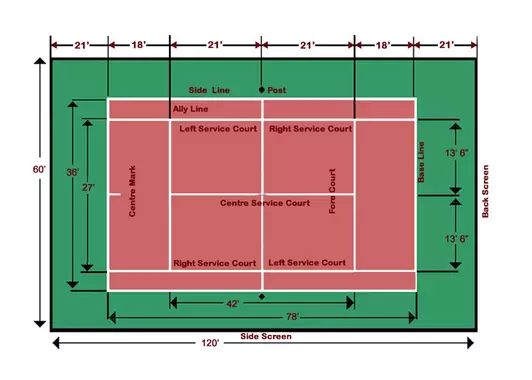
The rules of tennis are relatively straightforward:
- The game involves either “singles” or “doubles”, which means either 1 or 2 people on a team, and singles is a simple one-on-one match.
- Each tennis player stands on opposite sides of the net and hits a tennis ball back and forth with a racket.
- The “point” starts with one of the players performing a “serve”, and the other player must attempt to “return” the serve after it bounces at least once inside the “service box”.
- If the server misses the service box, they have a “fault” and can try a “second serve”, and if they fail again it’s a “double fault” and the server loses the point.
- If the serve hits the net cord and bounces inside the correct service box, it’s a “let” and the serve is repeated.
- If the opponent doesn’t return a valid serve, the server gets the point.
- Once the ball is in play, each player can win the point by keeping the ball within the court while also trying to force their opponent to make a mistake.
- A player can only hit the ball once before returning it to the other side of the net.
- The point ends when someone misses the ball, hits the ball out of the court or into the net, or the ball bounces twice.
- The point continues if the ball hits the net cord and bounces over the net on the correct side.
- When in play, the player loses the point if they touch the net or post, or if they cross over onto the opponent’s side of the court.
- The boundary lines of the court are part of the court. A ball that hits the line itself is still considered “in”.
The points are the only complex part of tennis:
- Every game involves a set number of matches, which is the best out of an odd number (e.g., best out of 5).
- Each player’s points progress from 0, to 15, to 30, to 40.
- If both players reach 40, it’s called “love”.
- A player can move to “advanced” if they score another point. However, if they lose right after that, the score is reset to “love”. If they score again after attaining “advanced”, they win the match.
Table tennis and ping pong are very similar, smaller versions of tennis, but they have semantic differences:
- Table tennis is 7 games of the best of 11 points, while ping pong is the best of 3 rounds of 15 points, with some other variations.
- Table tennis allows for various paddles, while ping pong requires everyone using the same paddle.
- Official games are run by either the ITTF (International Table Tennis Federation) or the World Championship of Ping-Pong.
Pickleball is a hybrid of tennis and table tennis, often played to scoring 11-points rounds for the best of 3.
Racquetball is a variation of tennis with a large, long room:
- Most of the rules of tennis are preserved (2-bounce rule, 1 strike per side, etc.).
- The requirement is to strike the racquetball across the “service line” with a racquet after bouncing it.
- Players take turns within the same court.
- There’s no out-of-bounds because it’s in a large room.
- Players aren’t allowed to interfere with their opponents’ turn.
Jai Alai is another racquetball variation, but involves launching a ball with gigantic scoops at a distant wall.
Volleyball is another variation of tennis, but typically involves a larger team and batting an inflated ball similar to a round soccer/football with your bare hands.
Racing
All races are the same: cross the finish line faster than your opponents, with everyone sharing the same constraints.
The only reason it’s still a “sport” is because each racer creates physical constraints against other racers.
- It stops being a sport when it’s a time attack.
- They’re sometimes distance races, but can sometimes be a test of endurance.
Once you understand the constraints of cycling, automotive, skiing, or whatever, you understand the race.
Mock Combat
The objective of a mock combat match is to subdue the other opponent, typically with restraints on what the combatant is permitted to perform. The conditions vary, but usually mean incapacitating their opponent.
Martial arts typically require only the approved maneuvers from that particular martial art, with the winner staying inside a ring.
Wrestling borrows from martial arts with approved maneuvers, but winning requires either performing more successful maneuvers than the opponent or pinning the person to the mat.
Boxing has bungees around the outside of the ring, and winning either requires delivering more connecting punches or getting the opponent to the floor where they don’t come back up again.
Mixed martial arts takes everything from boxing, but adds many more approved maneuvers and requires the opponent to be pinned like in wrestling.
Most popular video games for e-sports that aren’t strictly racing are mock combat arrangements, typically as thematic variations on first-person or third-person shooters.
Cue Sports & Croquet
Most cue sports (e.g., pool) and croquet involve the players taking turns using an implement to strike a target.
The “game” is heavily affected by the placement of the balls. Frequently, players’ actions can move balls that obstruct movement by other players.
Acrobatics
Each acrobatic endeavor is the same concept: perform spectacularly difficult maneuvers with a specified object.
It can be a skateboard, ice skates, or a unicycle, but the goals are clearly defined based on prior champions in that sport.
Pure Competitions
Other domains aren’t really “sports”, but are instead simply competitions.
- The psychological aspect of comparison is still present, but there is no interaction whatsoever from other participants in the role.
Some people debate that golf isn’t even a sport. In one sense, they’re correct because there’s very limited interaction with the other players, and the sport itself is more a hobby than a competition.
Fishing is the standard hobby of fishing, but with a time constraint and the objective to catch the largest or most fish.
Bowling is the standard hobby of bowling, but in parallel with other players.
All target shooting involves striking a distant object (or hitting as close as possible) with a specified distance weapon.
- Whether it’s shooting guns, bows, or horseshoes, the objective is effectively the same with small variations.